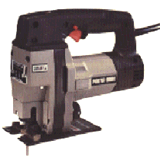
$90 upwards
The bayonet saw (also known as a jigsaw) is one of the most versatile saws you will ever own. It takes the place of a band saw, a scroll saw and even (to a more limited extent) a circular saw. As such, it is typically the first power saw you should consider buying.
Indeed, some bayonet saws can be fitted into a stand that allow you to fix the bayonet saw upside down onto a bench. This allows you to push the wood over the bayonet saw (rather than the more usual technique of pushing the bayonet saw over the wood) just like you would with a band saw.
The major limitations with a bayonet saw are the ability to cut in a straight line (see below for advice) and the thickness of cut. Really, anything thicker than about 1 1/2" is too thick for most bayonet saws.
When buying a bayonet saw you should consider the following:
Before starting to saw the wood, ensure that it is secured to the workbench. This is particularly important when cutting small pieces of wood. Always make sure that the bayonet saw is not going to come into contact with the workbench when you cut. Further, make sure that the electrical cable is positioned safely so that you cannot cut through it by mistake. When using the bayonet saw, do not force it forwards. A gentle amount of pressure is sufficient to cut through the wood and forcing it will only slow down the saw's operation.
To cut out a hole in the middle of a piece of wood (without cutting from the side) firstly drill a hole -- in the area that you intend to cut out -- that is larger than the width of the bayonet saw blade. Insert the bayonet saw into the hole and then begin cutting. Although you can "plunge cut" (begin cutting in the middle of a piece of wood without first making a hole) it is not as accurate.
To cut straight lines, clamp a metal rule parallel to the line you want to cut along to act as a guide. To further aid accuracy, use a wider bayonet saw blade -- this is less likely to curl outwards as you begin cutting -- and use a slower speed. Slower speeds, in general, allow you to cut more accurately, be it a freehand curve or a straight line.